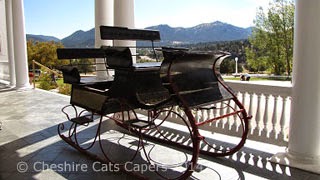Years ago, I discovered a
fascinating book called ‘A Lady’s Life in the Rocky Mountains’ by Isabella Bird. The book is a series of letters to her
sister in which she recounts her adventures and the people she met travelling
around Colorado in the mid 1800’s; by the end of the book I was hooked. Although I had absolutely no intention
travelling through the Rocky Mountains on horseback and definitely not in
November!
Since we retired and started
exploring the US, Rocky Mountain National Park has been somewhere we’ve tried
to visit several times, but on each occasion bad weather held us back.
This September we finally made it
and it was simply gorgeous.
On our first day in the park we
decided to drive Trail Ridge Road, as we knew that although the official
closure date was mid-October, bad weather could and probably would, close the
road at any time.
We started our drive from Estes Park
and right from the start the views were amazing.
Built between 1926 and 1932 Trail
Ridge Road is 48 miles long and is a designated All American Road, 11 miles of
the road are over 11,500 ft high and at its highest point it reaches an
elevation of 12,183 ft. Trail Ridge
Road is the highest continuous highway in the USA.
It’s hard to imagine that a glacier
500ft thick once covered this valley, it’s beautiful in the sunshine, but just
as spectacular as a thunderstorm creeps down the mountains.
As it climbs ever higher the road
travels through forests of aspen, and ponderosa pine, followed by subalpine
forests of fir and spruce before leaving the trees behind as it reaches fragile
windswept alpine tundra.
Old Fall River Road from Trail Ridge
Road
Autumn colours in Hidden Valley, the
valley once had a ski resort, it’s still possible to snowboard and sled here in the
winter.
Trail Ridge Road from Many Curves corner
as it winds up the mountain from Estes Park.
28 million years ago volcanic vents
12 miles away in the Never Summer Mountains were clogged with lava. A violent explosion of molten rock and gas formed
a fast moving avalanche, which when it stopped it fused into a solid mass. The dark rocks are welded tuff and known as
Lava Cliffs.
Trail Ridge road at one of its
highest points as it crosses the tundra.
It’s easy to see why it’s closed during the winter, as once the snows arrive
and the wind blows, how on earth would you be able to find the road?
The Never Summer Mountains, they often
have snow on them even during the summer, an informational sign told us they
were named by the Arapaho Indians because ‘summer never comes’! They’re the only volcanic mountain range in
Rocky Mountain National Park.
Huge logs on top of the Alpine
Visitor Centre help stop the roof caving in during the heavy snows of winter. We stopped here several times on our visits
to the park. It was almost always windy,
but the last time we stopped the wind was so strong I could barely open the
truck door.
The coffee shop has huge windows
with fabulous views of the alpine tundra, on our first visit there wasn’t a
seat to be had by the windows, on our second all the seats were free as the windows
had been boarded up. On our next visit water
was limited so only tea and coffee (sadly no hot chocolate!) were available, all
this was part of the closure preparations, in case of bad weather, which we
were told could close the road at any time and this was only mid-September!
Old Fall River Road, this was the first
road in Rocky Mountain National Park and opened in 1920. The one-way gravel road starts from Horseshoe
Park and follows an old Indian Trail as it climbs up to the Alpine Visitor
Centre. When we visited the road was
closed for repair after the disastrous floods in September 2013. Of course, this makes it yet another place
to add to our ever growing ‘to-revisit’ list!
Driving along high on Trail Ridge
Road, fabulous views on either side.
The one and only time we saw elk in
the park.
Have fun, we are!












































